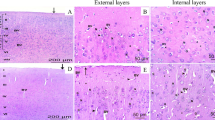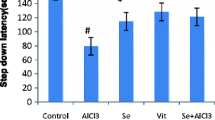Abstract
A potent antioxidant, selenium might modulate dementia-induced progression of brain and blood oxidative and apoptotic injuries. The present study explores whether selenium protects against experimental dementia (scopolamine, SCOP)-induced brain, and blood oxidative stress, apoptosis levels, and cytokine production in rats. Thirty-two rats were equally divided into four groups. The first group was used as an untreated control. The second group was treated with SCOP to induce dementia. The third and fourth groups received 1.5 mg/kg selenium (sodium selenite) and SCOP + selenium, respectively. Dementia was induced in the second and forth groups by intraperitoneal SCOP (1 mg/kg) administration. Brain, plasma, and erythrocyte lipid peroxidation levels as well as plasma TNF-α, interleukin (IL)-1β, and IL-4 levels were high in the SCOP group though they were low in selenium treatments. Selenium and selenium + SCOP treatments increased the lowered glutathione peroxidase activity, reduced glutathione, vitamins A and E concentrations in the brain, erythrocytes and plasma of the SCOP group. Apoptotic value expressions as active caspase-3, procaspase-9, and PARP were also increased by SCOP, while they were decreased by selenium and selenium + SCOP treatments. In conclusion, selenium induced protective effects against experimental dementia-induced brain, and blood oxidative injuries and apoptosis through regulation of cytokine production, vitamin E, glutathione concentrations, and glutathione peroxidase activity.





Similar content being viewed by others
Abbreviations
- GSH:
-
reduced glutathione
- GSH-Px:
-
glutathione peroxidase
- HBSS:
-
Hank’s buffered salt solution
- MDA:
-
malondialdehyde
- PARP:
-
poly (ADP-ribose) polymerase
- RME:
-
reference memory error
- ROS:
-
reactive oxygen species
- SCOP:
-
scopolamine
- TRP:
-
transient receptor potential
- WME:
-
working memory error
References
Balaban H, Nazıroğlu M, Demirci K, Övey İS (2016) The protective role of selenium on scopolamine-induced memory impairment, oxidative stress, and apoptosis in aged rats: the involvement of TRPM2 and TRPV1 channels. Mol Neurobiol. doi:10.1007/s12035-016-9835-0
Berr C, Arnaud J, Akbaraly TN (2012) Selenium and cognitive impairment: a brief-review based on results from the EVA study. Biofactors 38:139–144
Bütün A, Nazıroğlu M, Demirci S, Çelik Ö, Uğuz AC (2015) Riboflavin and vitamin E increase brain calcium and antioxidants, and microsomal calcium-ATP-ase values in rat headache models induced by glyceryl trinitrate. J Membr Biol 248:205–213
Chen W, Cheng X, Chen J, Yi X, Nie D, Sun X, Qin J, Tian M, Jin G, Zhang X. Lycium barbarum Polysaccharides prevent memory and neurogenesis impairments in scopolamine-treated rats. PLoS One 2014a;9:e88076.
Chen C, Li XH, Zhang S, Tu Y, Wang YM, Sun HT (2014b) 7,8-dihydroxyflavone ameliorates scopolamine-induced Alzheimer-like pathologic dysfunction. Rejuvenation Res 17:249–254
Desai ID (1984) Vitamin E analysis methods for animal tissues. Methods Enzymol 105:138–147
Eidi A, Eidi M, Mahmoodi G, Oryan S (2006) Effect of vitamin E on memory retention in rats: possible involvement of cholinergic system. Eur Neuropsychopharmacol 16:101–106
Espino J, Bejarano I, Redondo PC, Rosado JA, Barriga C, Reiter RJ, Pariente JA, Rodríguez AB (2010) Melatonin reduces apoptosis induced by calcium signaling in human leukocytes: evidence for the involvement of mitochondria and Bax activation. J Membr Biol 233:105–118
Giraldo E, Lloret A, Fuchsberger T, Viña J (2014) Aβ and tau toxicities in Alzheimer’s are linked via oxidative stress-induced p38 activation: protective role of vitamin E. Redox Biol 2:873–877
Hancianu M, Cioanca O, Mihasan M, Hritcu L (2013) Neuroprotective effects of inhaled lavender oil on scopolamine-induced dementia via anti-oxidative activities in rats. Phytomedicine 20:446–452
Harrison FE, Hosseini AH, Dawes SM, Weaver S, May JM (2009) Ascorbic acid attenuates scopolamine-induced spatial learning deficits in the water maze. Behav Brain Res 205:550–558
Hou XQ, DW W, Zhang CX, Yan R, Yang C, Rong CP, Zhang L, Chang X, RY S, Zhang SJ, He WQ, Qu Z, Li S, ZR S, Chen YB, Wang Q, Fang SH (2014) Bushen-Yizhi formula ameliorates cognition deficits and attenuates oxidative stress-related neuronal apoptosis in scopolamine-induced senescence in mice. Int J Mol Med 34:429–439
Jang YJ, Kim J, Shim J, Kim CY, Jang JH, Lee KW, Lee HJ. Decaffeinated coffee prevents scopolamine-induced memory impairment in rats. Behav Brain Res 2013;245:113–119.
Jung HA, Jin SE, Choi RJ, Kim DH, Kim YS, Ryu JH, Kim DW, Son YK, Park JJ, Choi JS (2010) Anti-amnesic activity of neferine with antioxidant and anti-inflammatory capacities, as well as inhibition of ChEs and BACE1. Life Sci 87:420–430
Kahya MC, Naziroğlu M, Çiğ B (2015) Melatonin and selenium reduce plasma cytokine and brain oxidative stress levels in diabetic rats. Brain Inj 29:1490–1406
Kahya MC, Nazıroğlu M, Çiğ B (2016) Modulation of diabetes-induced oxidative stress, apoptosis, and Ca2+ entry through TRPM2 and TRPV1 channels in dorsal root ganglion and hippocampus of diabetic rats by melatonim and selenium. Mol Neurobiol. doi:10.1007/s12035-016-9727-3
Kang J, Park EJ, Jou I, Kim JH, Joe EH (2001) Reactive oxygen species mediate a beta(25-35)-induced activation of BV-2 microglia. Neuroreport 12:1449–1452
Koç ER, Ilhan A, Zübeyde A, Acar B, Gürler M, Altuntaş A, Karapirli M, Bodur AS (2015) A comparison of hair and serum trace elements in patients with Alzheimer disease and healthy participants. Turk J Med Sci 45:1034–1039
Lawrence RA, Burk RF (1976) Glutathione peroxidase activity in selenium-deficient rat liver. Biochem Biophys Res Com 71:952–958
Li P, Nijhawan D, Budihardjo I, Srinivasula SM, Ahmad M, Alnemri ES, Wang X (1997) Cytochrome c and dATPdependent formation of Apaf-1/caspase-9 complex initiates an apoptotic protease cascade. Cell 91:479–489
Lowry OH, Rosebrough NJ, Farr AL, Randall RJ (1951) Protein measurement with the Folin- phenol reagent. J Biol Chem 193:265–275
Mitsuhashi M, Taub DD, Kapogiannis D, Eitan E, Zukley L, Mattson MP, Ferrucci L, Schwartz JB, Goetzl EJ (2013) Aging enhances release of exosomal cytokine mRNAs by Aβ1-42-stimulated macrophages. FASEB J 27:5141–5150
Nazıroğlu M (2007) New molecular mechanisms on the activation of TRPM2 channels by oxidative stress and ADP-ribose. Neurochem Res 32:1990–2001
Nazıroğlu M (2009) Role of selenium on calcium signaling and oxidative stress-induced molecular pathways in epilepsy. Neurochem Res 34:2181–2191
Nazıroğlu M (2011) TRPM2 cation channels, oxidative stress and neurological diseases: Where are we now? Neurochem Res 36:355–366
Nazıroğlu M, Yürekli VA (2013) Effects of antiepileptic drugs on antioxidant and oxidant molecular pathways: focus on trace elements. Cell Mol Neurobiol 33:589–599
Neha Sodhi RK, Jaggi AS, Singh N (2014) Animal models of dementia and cognitive dysfunction. Life Sci 109:73–86
Parajuli B, Sonobe Y, Horiuchi H, Takeuchi H, Mizuno T, Suzumura A (2013) Oligomeric amyloid β induces IL-1β processing via production of ROS: implication in Alzheimer’s disease. Cell Death Dis 4:e975
Park KW, Baik HH, Jin BK (2008) Interleukin-4-induced oxidative stress via microglial NADPH oxidase contributes to the death of hippocampal neurons in vivo. Curr Aging Sci 1:192–201
Pecze L, Blum W, Schwaller B (2013) Mechanism of capsaicin receptor TRPV1-mediated toxicity in pain-sensing neurons focusing on the effects of Na(+)/Ca(2+) fluxes and the Ca(2+)-binding protein calretinin. Biochim Biophys Acta 1833:1680–1691
Placer ZA, Cushman L, Johnson BC (1966) Estimation of products of lipid peroxidation (malonyl dialdehyde) in biological fluids. Analytical. Biochem 16:359–364
Rita Cardoso B, Silva Bandeira V, Jacob-Filho W, Franciscato Cozzolino SM (2014) Selenium status in elderly: relation to cognitive decline. J Trace Elem Med Biol. 28:422–426
Rossi L, Mazzitelli S, Arciello M, Capo CR, Rotilio G (2008) Benefits from dietary polyphenols for brain aging and Alzheimer’s disease. Neurochem Res 33:2390–2400
Sedlak J, Lindsay RHC (1968) Estimation of total, protein bound and non-protein sulfhydryl groups in tissue with Ellmann’ s reagent. Analytical. Biochem 25:192–205
Senol N, Nazıroğlu M, Yürüker VN (2014) Acetylcysteine and selenium modulate oxidative stress, antioxidant vitamin and cytokine values in traumatic brain injury-induced rats. Neurochem Res 39:685–692
Sezgin Z, Dincer Y (2014) Alzheimer’s disease and epigenetic diet. Neurochem Int 78:105–116
Suzuki J, Katoh NA (1990) Simple and cheap method for measuring vitamin a in cattle using only a spectrophotometer. Jpn. J Vet Sci 52:1282–1284
Tsai FS, LY W, Yang SE, Cheng HY, Tsai CC, CR W, Lin LW (2015) Ferulic acid reverses the cognitive dysfunction caused by amyloid β peptide 1-40 through anti-oxidant activity and cholinergic activation in rats. Am J Chin Med 43:319–335
Uğuz AC, Naziroğlu M, Espino J, Bejarano I, González D, Rodríguez AB, Pariente JA (2009) Selenium modulates oxidative stress-induced cell apoptosis in human myeloid HL-60 cells through regulation of calcium release and caspase-3 and −9 activities. J Membr Biol. 232:15–23
Xiao J, Li S, Sui Y, Wu Q, Li X, Xie B, Zhang M, Sun Z (2014) Lactobacillus casei-01 facilitates the ameliorative effects of proanthocyanidins extracted from lotus seedpod on learning and memory impairment in scopolamine-induced amnesia mice. PLoS One 9:e112773
Author information
Authors and Affiliations
Corresponding author
Ethics declarations
Financial disclosure
There is no financial disclosure for the current study.
Disclosures
None of the authors have any conflicts to disclose. All authors approved the final manuscript.
Rights and permissions
About this article
Cite this article
Demirci, K., Nazıroğlu, M., Övey, İ.S. et al. Selenium attenuates apoptosis, inflammation and oxidative stress in the blood and brain of aged rats with scopolamine-induced dementia. Metab Brain Dis 32, 321–329 (2017). https://doi.org/10.1007/s11011-016-9903-1
Received:
Accepted:
Published:
Issue Date:
DOI: https://doi.org/10.1007/s11011-016-9903-1




